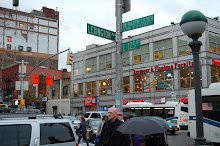Saturday 1st May
As part of the London Sinfonietta's three-day Experiment! season at King's Place near King's Cross, Saturday afternoon and evening saw the resurrection of an ensemble that has not been heard of for a while - The Scratch Orchestra. The original Scratch Orchestra was formed by the late Cornelius Cardew in 1969, bringing together musicians (and non-musicians) from a variety of backgrounds including classically-trained players, improvisers and those keen to experiment. One of the original Scratch Orchestra members was composer Michael Parsons, whose composition Apartment House Suite No. 1 had been performed by the London Sinfonietta on Friday evening, alongside compositions by John Lely, Cardew, David Smith, Howard Skempton, Gavin Bryars and Michael Nyman, as part of a programme entitled British Experiments, (Thursday evening had seen a similar programme entitled American Experiments, including works by Henry Cowell, Christian Wolff, Morton Feldman and John Cage.)
Saturday was planned as a full day of activity, in keeping with Experiment!'s strapline "a three-day festival of adventurous music in unexpected places". From 6am until midnight, an ongoing free performance took place of Erik Satie's Vexations, with its 840 repititions of a short motif. The publicity for the Saturday afternoon session read, "Join London Sinfonietta's Scratch Band"; at 2pm twenty-one volunteers assembled for the workshop which was to be led by Parsons and Experiment! curator Robert Worby. The results of the workshop were to form part of a free public performance early on Saturday evening, sandwiched between performances of Steve Reich's Six Marimbas by members of London Sinfonietta. Parsons began the afternoon workshop with a brief history lesson that outlined the ethos and working methods of the original Scratch Orchestra, methods that were to be used in the workshop. Participants had been asked to bring a glass bottle full of drink (not alcohol!) and a harmonica if they possessed one; these were to be used in two of the pieces planned for the evening performance.
The opening activity of the workshop soon emphasised the ethos of combining musicians, improvisers and others into one ensemble. Sheet music of Christian Wolff's composition Burdocks was circulated and those who could sight read music were asked to play it together. For those who didn't sight read, there was a rhythmic accompaniment that they could reproduce using any means. When the entire ensemble played the piece together, the results were impressive - the group of people there worked well together. Next up was a looser playing activity; in groups of five. One player started off making a single sound (of long or short duration) and then with a signal passed on to the player on their left who made their own sound, and so on around the ring, with no gaps allowed between the sounds. Once the groups had had time to get used to the activity, Parsons and Worby cued different groups in at different times, creating a shifting soundscape as groups were faded in and out.
Another scored piece followed, part of Sibelius's Karelia Suite. Again the end result sounded good although, after a couple of run-throughs, Worby was concerned lest it become too slick - clearly not the intention of this exercise. The session closed with run-throughs of John White's Sipping and Blowing for which we needed our bottles. Starting with a full bottle, we had to drink a specified amount (nothing or a sip or a gulp) before blowing across the neck of the bottle a specified number of times, to generate a note. And so on until the bottle was empty. Finally, we used our harmonicas to play John Lely's Harmonica High; a group of players started together, each playing the lowest note on their harmonica. They gradually spread out, further and further apart, playing higher and higher notes on their harmonicas.
After a break, we reassembled in Hall 2, where our evening performance would begin. Parsons and Worby led us through the running order and the changeovers, preparing us for the real thing. At 6-50pm, as the first performance of Six Marimbas ended, it was our time. The audience gradually drifted into Hall 2 as we passed our sounds around the groups of five. Then we came together to perform Burdocks and Karelia Suite (to applause!) before ending by dispersing into the foyer while playing Sipping and Blowing and Harmonica High. Then, happy and satisfied, we were gone.

